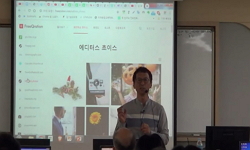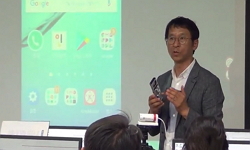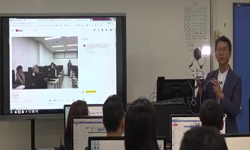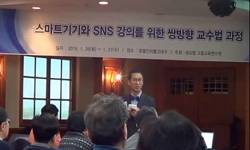대부분의 유교의례가 그러하듯 서원의 향사도 시대 흐름에 따른 변화를 비껴갈 수는 없다. 도산서원의 경우 축시丑時(새벽 1시~3시)였던 향사 시각을 2009년부터 오전 11시로 변경했으며 2박 ...
http://chineseinput.net/에서 pinyin(병음)방식으로 중국어를 변환할 수 있습니다.
변환된 중국어를 복사하여 사용하시면 됩니다.
- 中文 을 입력하시려면 zhongwen을 입력하시고 space를누르시면됩니다.
- 北京 을 입력하시려면 beijing을 입력하시고 space를 누르시면 됩니다.

서원 향사享祀의 변화와 사회문화적 의미 ― ‘도산서원’ 사례를 중심으로 = The Change and Sociocultural meanings of Rites of Seowon ― With focus on Dosan Seowon
한글로보기https://www.riss.kr/link?id=A104026621
-
저자
김미영 (한국국학진흥원)
- 발행기관
- 학술지명
- 권호사항
-
발행연도
2013
-
작성언어
Korean
-
주제어
Seowon ; Confucianist Temples ; Rites of Seowon ; Confucianist Ritual ; Memorial Tablet ; Purification ; Sacrifice ; 서원 ; 향교 ; 향사 ; 유교의례 ; 위패 ; 재계 ; 제물 ; Seowon ; Confucianist Temples ; Rites of Seowon ; Confucianist Ritual ; Memorial Tablet ; Purification ; Sacrifice
-
등재정보
KCI등재
-
자료형태
학술저널
-
수록면
9-38(30쪽)
-
KCI 피인용횟수
7
- DOI식별코드
- 제공처
- 소장기관
-
0
상세조회 -
0
다운로드
부가정보
국문 초록 (Abstract)
향사의 내용에서도 변화가 나타난다. 석미례淅米禮의 경우 지금은 쌀과 기장을 담은 함지를 들고 정문 밖의 수돗가에서 씻는데, 안동댐이 건설되기 이전만 하더라도 배를 타고 강으로 나가서 거행했다. 신위에게 올릴 제물인지라 평소 사람들이 사용하지 않고 또 눈에 띄지 않는 곳에서 수행함으로써 제물에 신성성을 부여하기 위함이다. 그러나 안동댐 건설로 강이 사라지게 되면서 관람객들이 물을 마시고 손을 씻는 수도를 이용하게 된 것이다. 이로써 제물의 신성성 확보에는 다소 불리하게 된 셈이다. 그러는 가운데 쌀을 일지 않고 물로만 씻어내는 방식은 여전히 준수하면서 신성성 확보를 위한 노력을 기울이고 있다. 시생豕牲(돼지)의 경우에도 원래는 살아있는 돼지를 메고 와서 생간품牲看品을 행한 뒤 고직사 옆에서 직접 도축했다. 그리고 돼지 내장 등의 부산물은 제관들의 야화(밤참)에 사용했으나, 도축법 개정에 의해 2009년부터 단골정육점에 부탁하여 미리 반으로 토막 낸 냉동돼지를 구입하는 방식으로 바뀌었다. 그러면서 야화상에 차려지던 돼지내장은 시장에서 별도로 구입하여 장만하게 되었다. 이로써 비록 형식은 바뀌었지만, 내용은 유지하게 된 셈이다. 이처럼 향사의 절차와 내용에서 일어나는 변화의 대부분은 외적 상황에 따른 것으로, 향사의 전승지속력을 확보하기 위해 시대적 흐름에 맞게 개선했다는 표현이 더 적절할 듯하다.
의례수행집단의 경우에는 여타 서원과 마찬가지로 큰 변화를 겪고 있는 실정이다. 대표적인 것은 취사제도取士制度의 소멸이다. 도산서원 향사의 지침서로 활용되고 있는 「의절초儀節草」에는 예안 향내에서 추천을 받은 뒤 공사원公事員들의 투표에 의해 선정하도록 명시되어 있지만, 지금은 예안을 넘어 안동‧영남‧전국으로 범위를 확대시켜도 추천자체가 아예 사라져버렸다. 그러다보니 선발방식도 추천이 아니라 직접적인 의뢰형식으로 바뀌었다. 또 「의절초」의 ‘30세 이상의 문행文行이 있는 사람’이라는 자격조건은 ‘유림관계자 중에서 평판이 무난한 사람’이라는, 다소 유연한 조건으로 대체되었다. 이처럼 취사제도가 사라짐에 따라 향사의 참례 자체가 갖는 사회정치적 의미도 크게 약화되었는데, 이는 제관을 선출하는 분정分定 절차를 완화시키는 요인으로 작용하기도 한다.
그런가 하면, 이러한 변화양상의 배경에는 다음의 두 가지 원인이 자리하고 있다. 우선 향사를 비롯한 대부분의 유교의례는 문자(한문)의 이해가 필수적이다. 특히 절차의 엄정성을 중시하는 서원 향사는 더욱 그러하다. 이런 연유로 한문에 익숙하지 않는 현대인들이 참례할 수 있는 기회가 점점 줄어들고 있는 것이다. 아울러 향사에 대한 인식의 변화도 의례수행집단의 유지에 불리하게 작 ...
대부분의 유교의례가 그러하듯 서원의 향사도 시대 흐름에 따른 변화를 비껴갈 수는 없다. 도산서원의 경우 축시丑時(새벽 1시~3시)였던 향사 시각을 2009년부터 오전 11시로 변경했으며 2박 3일에 걸쳐 거행하던 향사 기간을 1박 2일로 단축했다. 이는 시간 운용이 비교적 자유로운 농업 위주의 전통사회와 달리 시간적 구속력이 강한 생업에 종사하고 있는 현대인들의 생활양식으로 인한 변화라고 할 수 있다. 또 지금까지 비공개로 거행하던 향사를 남녀 구분없이 누구나 참관할 수 있도록 개방했으며 그동안 금지되었던 여성의 사당참배를 허용하기도 했다.
향사의 내용에서도 변화가 나타난다. 석미례淅米禮의 경우 지금은 쌀과 기장을 담은 함지를 들고 정문 밖의 수돗가에서 씻는데, 안동댐이 건설되기 이전만 하더라도 배를 타고 강으로 나가서 거행했다. 신위에게 올릴 제물인지라 평소 사람들이 사용하지 않고 또 눈에 띄지 않는 곳에서 수행함으로써 제물에 신성성을 부여하기 위함이다. 그러나 안동댐 건설로 강이 사라지게 되면서 관람객들이 물을 마시고 손을 씻는 수도를 이용하게 된 것이다. 이로써 제물의 신성성 확보에는 다소 불리하게 된 셈이다. 그러는 가운데 쌀을 일지 않고 물로만 씻어내는 방식은 여전히 준수하면서 신성성 확보를 위한 노력을 기울이고 있다. 시생豕牲(돼지)의 경우에도 원래는 살아있는 돼지를 메고 와서 생간품牲看品을 행한 뒤 고직사 옆에서 직접 도축했다. 그리고 돼지 내장 등의 부산물은 제관들의 야화(밤참)에 사용했으나, 도축법 개정에 의해 2009년부터 단골정육점에 부탁하여 미리 반으로 토막 낸 냉동돼지를 구입하는 방식으로 바뀌었다. 그러면서 야화상에 차려지던 돼지내장은 시장에서 별도로 구입하여 장만하게 되었다. 이로써 비록 형식은 바뀌었지만, 내용은 유지하게 된 셈이다. 이처럼 향사의 절차와 내용에서 일어나는 변화의 대부분은 외적 상황에 따른 것으로, 향사의 전승지속력을 확보하기 위해 시대적 흐름에 맞게 개선했다는 표현이 더 적절할 듯하다.
의례수행집단의 경우에는 여타 서원과 마찬가지로 큰 변화를 겪고 있는 실정이다. 대표적인 것은 취사제도取士制度의 소멸이다. 도산서원 향사의 지침서로 활용되고 있는 「의절초儀節草」에는 예안 향내에서 추천을 받은 뒤 공사원公事員들의 투표에 의해 선정하도록 명시되어 있지만, 지금은 예안을 넘어 안동‧영남‧전국으로 범위를 확대시켜도 추천자체가 아예 사라져버렸다. 그러다보니 선발방식도 추천이 아니라 직접적인 의뢰형식으로 바뀌었다. 또 「의절초」의 ‘30세 이상의 문행文行이 있는 사람’이라는 자격조건은 ‘유림관계자 중에서 평판이 무난한 사람’이라는, 다소 유연한 조건으로 대체되었다. 이처럼 취사제도가 사라짐에 따라 향사의 참례 자체가 갖는 사회정치적 의미도 크게 약화되었는데, 이는 제관을 선출하는 분정分定 절차를 완화시키는 요인으로 작용하기도 한다.
그런가 하면, 이러한 변화양상의 배경에는 다음의 두 가지 원인이 자리하고 있다. 우선 향사를 비롯한 대부분의 유교의례는 문자(한문)의 이해가 필수적이다. 특히 절차의 엄정성을 중시하는 서원 향사는 더욱 그러하다. 이런 연유로 한문에 익숙하지 않는 현대인들이 참례할 수 있는 기회가 점점 줄어들고 있는 것이다. 아울러 향사에 대한 인식의 변화도 의례수행집단의 유지에 불리하게 작 ...
다국어 초록 (Multilingual Abstract)
There were also changes in the contents of the ritual. Seok- mi-rae(淅米禮) is a ritual where a large wooden bowl full of rice and millet is taken outside the main doors and washed at the faucet outside. However, before the Andong dam was built, this ritual was carried out at the river by boat, in order to add sacredness to the sacrifice that was to be put on the memorial tablet by carrying out the ritual somewhere that is not used by or hidden from most. However, as the river disappeared after the Andong dam was built, the faucet that participants drink water from and wash their hands with was used in the ritual. Thus, it has become difficult to add sacredness to this ritual. However, the tradition of washing the rice without straining it is still being kept as an attempt to preserve sacredness. Si-saeng(豕牲), the examination of sacrifice, usually pigs, was carried out traditionally by bringing a live pig and carrying out saeng-gan-pum(牲看品) and directly killing the pig next to the Go-jik-sa. After the pigs organs and by-products were used as night snacks for participants, however since the amendment in the butchery law in 2009, the ritual has changed to purchasing a frozen pig cut in half by a designated butcher's shop. Thus organs for the night snack are now required to be separately purchased in the market. Like this, although the formalities of the ritual have changed, the contents have been maintained. Like this, the changes in the process or contents of the ritual were mainly caused by external factors, therefore the changes are best described as having been modernized in order to ensure continuance.
Ritual groups too are experiencing great changes like all other seowons. The biggest change is the extinction of the scholar selection system(取士制度). The guidelines of the Dosan seowon, Eui-jeol-cho「儀節草」, specifies that upon receiving recommendation from Yean(禮安), the public ministers are to vote and choose scholars. However, this recommendation system has disappeared not only from Yean but also in the likes of Andong, Youngnam and the rest of the country. Therefore, it is no longer a selection or recommendation process but a direct request. In addition, the condition specified in the Eui- jeol-cho that requires a scholar to be “greater than 30 years old that studies literature” was changed to “a Confucian scholar with a ordinary reputation”. Like this, with the disappearance of the scholar selection system, the sociopolitical significance of the Rites of Seowon itself has largely decreased and has also led to relieving the segregation process of selecting sacrifice participants. Behind such change, the following reason lies. First, a majority of Confucinanist rituals including Rites of Seowon require literacy of Chinese traditional characters. This is greatly emphasized in seowons that consider the strictness in process. As a result, the opportunity for modern day people, who lack an understanding in Chinese characters, to participate in rituals is decreasing. Furthermore, the changes in awareness of the Rites of Seowon has made it more difficult for maintaining the ritual group. When Confucianist values prevailed, the Rites of Seowon held a critical position in the societ...
Like most confucianist rituals, the passing of time inevitably changed Rites of Seowon. In the case of the Dosan Seowon, the Chooksi(丑時) which originally took place between 1 and 3 a.m. was changed to 11 a.m. as of 2009 and the duration of the rit...
Like most confucianist rituals, the passing of time inevitably changed Rites of Seowon. In the case of the Dosan Seowon, the Chooksi(丑時) which originally took place between 1 and 3 a.m. was changed to 11 a.m. as of 2009 and the duration of the ritual was shortened from two nights and three days to one night and one day. This change took place because compared to the agricultural traditional society with relatively greater freedom in time, the modern day people sustain themselves by working in jobs that have greater time constraints. Furthermore, this ritual which was previously carried out privately, has been opened to all genders enabling females to pay respects to shrines, which was previously prohibited.
There were also changes in the contents of the ritual. Seok- mi-rae(淅米禮) is a ritual where a large wooden bowl full of rice and millet is taken outside the main doors and washed at the faucet outside. However, before the Andong dam was built, this ritual was carried out at the river by boat, in order to add sacredness to the sacrifice that was to be put on the memorial tablet by carrying out the ritual somewhere that is not used by or hidden from most. However, as the river disappeared after the Andong dam was built, the faucet that participants drink water from and wash their hands with was used in the ritual. Thus, it has become difficult to add sacredness to this ritual. However, the tradition of washing the rice without straining it is still being kept as an attempt to preserve sacredness. Si-saeng(豕牲), the examination of sacrifice, usually pigs, was carried out traditionally by bringing a live pig and carrying out saeng-gan-pum(牲看品) and directly killing the pig next to the Go-jik-sa. After the pigs organs and by-products were used as night snacks for participants, however since the amendment in the butchery law in 2009, the ritual has changed to purchasing a frozen pig cut in half by a designated butcher's shop. Thus organs for the night snack are now required to be separately purchased in the market. Like this, although the formalities of the ritual have changed, the contents have been maintained. Like this, the changes in the process or contents of the ritual were mainly caused by external factors, therefore the changes are best described as having been modernized in order to ensure continuance.
Ritual groups too are experiencing great changes like all other seowons. The biggest change is the extinction of the scholar selection system(取士制度). The guidelines of the Dosan seowon, Eui-jeol-cho「儀節草」, specifies that upon receiving recommendation from Yean(禮安), the public ministers are to vote and choose scholars. However, this recommendation system has disappeared not only from Yean but also in the likes of Andong, Youngnam and the rest of the country. Therefore, it is no longer a selection or recommendation process but a direct request. In addition, the condition specified in the Eui- jeol-cho that requires a scholar to be “greater than 30 years old that studies literature” was changed to “a Confucian scholar with a ordinary reputation”. Like this, with the disappearance of the scholar selection system, the sociopolitical significance of the Rites of Seowon itself has largely decreased and has also led to relieving the segregation process of selecting sacrifice participants. Behind such change, the following reason lies. First, a majority of Confucinanist rituals including Rites of Seowon require literacy of Chinese traditional characters. This is greatly emphasized in seowons that consider the strictness in process. As a result, the opportunity for modern day people, who lack an understanding in Chinese characters, to participate in rituals is decreasing. Furthermore, the changes in awareness of the Rites of Seowon has made it more difficult for maintaining the ritual group. When Confucianist values prevailed, the Rites of Seowon held a critical position in the societ...
참고문헌 (Reference)
1 권삼문, "향사의 지속과 변화" 안동대민속학연구소 9 : 1999
2 권삼문, "향사의 역사와 구조" 한국역사민속학회 12 : 2001
3 정순목, "한국서원교육제도연구" 영남대학교 출판부 1979
4 이훈상, "한국 사회의 유교적 변환" 아카넷 2003
5 김경미, "조선중기 예학사상과 일상문화" 이화여자대학교출판부 2008
6 정순우, "조선시대 제향공간의 성격과 그 사회사적 의미" 한국사회사학회 53 : 1998
7 김미영, "제사 모셔가기’에 나타난 유교이념과 양반지향성" 안동대학교 민속학연구소 9 : 1999
8 조성윤, "정치와 종교-조선시대의 유교의례" 한국사회사학회 53 : 1998
9 김상준, "유교의 예치이념과 조선" 청계 2007
10 한도현, "유교의 예와 현대적 해석" 청계 2004
1 권삼문, "향사의 지속과 변화" 안동대민속학연구소 9 : 1999
2 권삼문, "향사의 역사와 구조" 한국역사민속학회 12 : 2001
3 정순목, "한국서원교육제도연구" 영남대학교 출판부 1979
4 이훈상, "한국 사회의 유교적 변환" 아카넷 2003
5 김경미, "조선중기 예학사상과 일상문화" 이화여자대학교출판부 2008
6 정순우, "조선시대 제향공간의 성격과 그 사회사적 의미" 한국사회사학회 53 : 1998
7 김미영, "제사 모셔가기’에 나타난 유교이념과 양반지향성" 안동대학교 민속학연구소 9 : 1999
8 조성윤, "정치와 종교-조선시대의 유교의례" 한국사회사학회 53 : 1998
9 김상준, "유교의 예치이념과 조선" 청계 2007
10 한도현, "유교의 예와 현대적 해석" 청계 2004
11 삐에르 부르디외, "상징폭력과 문화재생산" 새물결 1997
12 하워드J. 웨슬러, "비단같고 주옥같은 정치" 고즈윈 2005
동일학술지(권/호) 다른 논문
-
- 한국국학진흥원
- 박정해(朴正海)
- 2013
- KCI등재
-
- 한국국학진흥원
- 김미영(金美榮)
- 2013
- KCI등재
-
- 한국국학진흥원
- 이황진(李黃振)
- 2013
- KCI등재
-
한국국학진흥원 목판 아카이브 구축 및 서비스 방향에 대한 연구
- 한국국학진흥원
- 최희수(崔熙洙)
- 2013
- KCI등재
분석정보
인용정보 인용지수 설명보기
학술지 이력
| 연월일 | 이력구분 | 이력상세 | 등재구분 |
|---|---|---|---|
| 2028 | 평가예정 | 재인증평가 신청대상 (재인증) | |
| 2022-01-01 | 평가 | 등재학술지 유지 (재인증) |  |
| 2019-08-01 | 학회명변경 | 영문명 : Korea Studies Adancement Center -> The Korean Studies Institute |  |
| 2019-01-01 | 평가 | 등재학술지 유지 (계속평가) |  |
| 2016-01-01 | 평가 | 등재학술지 유지 (계속평가) |  |
| 2012-01-01 | 평가 | 등재학술지 유지 (등재유지) |  |
| 2009-01-01 | 평가 | 등재학술지 선정 (등재후보2차) |  |
| 2008-01-01 | 평가 | 등재후보 1차 PASS (등재후보1차) |  |
| 2006-01-01 | 평가 | 등재후보학술지 선정 (신규평가) |  |
학술지 인용정보
| 기준연도 | WOS-KCI 통합IF(2년) | KCIF(2년) | KCIF(3년) |
|---|---|---|---|
| 2016 | 0.65 | 0.65 | 0.61 |
| KCIF(4년) | KCIF(5년) | 중심성지수(3년) | 즉시성지수 |
| 0.56 | 0.62 | 1.324 | 0.18 |




 KCI
KCI







